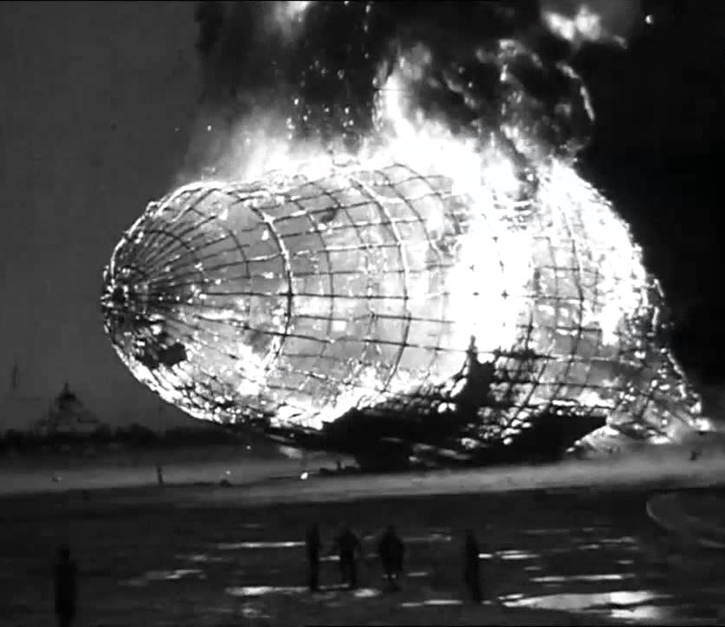Brief overview of the he Hindenburg Tragedy / disaster that occurred in 1937. The Hindenburg was a German passenger airship that caught fire and was destroyed during its attempt to land in Lakehurst, New Jersey, on May 6, 1937. The disaster resulted in the deaths of 36 people, including passengers and crew members.
The Hindenburg was a large German commercial passenger-carrying rigid airship. On that fateful day, as it was approaching its landing, a fire broke out in the tail section of the airship. The flames quickly engulfed the entire structure, causing the Hindenburg to crash to the ground.
The exact cause of the fire has been a subject of debate and investigation. Some theories suggest that a spark ignited the highly flammable hydrogen gas that filled the airship’s compartments. Others argue that the fire may have been caused by a combination of factors, including static electricity and weather conditions.
The disaster marked the end of the era of passenger-carrying rigid airships, as public confidence in the safety of such travel was severely shaken. The Hindenburg disaster is one of the most well-known airship accidents in history.
A Luxurious Leviathan Takes Flight:
The LZ 129 Hindenburg, named after the German president Paul von Hindenburg, was no ordinary flying machine. At a staggering 804 feet long and 411 feet high, it was the largest airship ever built, dwarfing even skyscrapers of the time. Its luxurious interior boasted amenities like a grand dining hall, smoking rooms, and even a promenade deck. It offered a transatlantic travel experience unlike any other, gliding serenely above the vast ocean, promising escape and a touch of avant-garde elegance.
A Shadow Looms:
Despite its technological marvel and opulent trappings, the Hindenburg harbored a hidden vulnerability – its reliance on hydrogen for lift. Due to political tensions and U.S. restrictions, helium, a safer alternative, was unavailable. Hydrogen, while lighter, posed a significant fire risk. This ominous undercurrent lurked beneath the gleaming facade of the airship.
A Fateful Evening:
On that fateful evening in May, the Hindenburg approached Lakehurst Naval Air Station in New Jersey for its 36th transatlantic crossing. As it prepared to dock, witnesses on the ground reported sparks near the tail. Then, in a moment of terrifying swiftness, flames erupted. The immense airship transformed into a torch, its hydrogen-filled frame succumbing to the inferno in a matter of minutes.
Loss and Survival:
The Hindenburg’s fiery fall claimed 36 lives, 13 passengers, and 22 crew members, alongside one ground crewman. Miraculously, 62 people, including 23 passengers and 39 crew, managed to escape the inferno, leaping from the burning wreckage or scrambling down mooring lines. Their harrowing accounts and vivid memories provided the world with a first-hand perspective of the disaster.
End of an Era:
The Hindenburg tragedy shattered the public’s confidence in airships. The dream of majestic, leisurely ocean crossings in luxurious flying palaces, forever tainted by the memory of that fiery evening. While airships continued to operate for a few years, their era effectively ended with the Hindenburg’s demise.

A Legacy Beyond the Flames:
The Hindenburg disaster continues to resonate in our collective memory for several reasons. It serves as a stark reminder of the ever-present threat of technological vulnerabilities. It sheds light on the human cost of innovation and progress. And finally, it stands as a haunting testament to the fleeting nature of human ambition, with the once-majestic airship reduced to ashes in a matter of minutes.
In conclusion, the Hindenburg tragedy was not just an aviation accident; it was a turning point in history. It marked the end of an era, leaving behind a legacy of awe, caution, and poignant reflection on the human journey towards technological triumph and potential peril.
Further Exploration:
- Watch the newsreel footage of the Hindenburg disaster, available on YouTube.
- Visit the National Air and Space Museum in Washington D.C. to see the remains of the Hindenburg’s mooring mast.
- Read books like “The Hindenburg Disaster” by Michael J. Mooney or “Hindenburg: An Illustrated History” by Tom Crouch.
The Hindenburg story serves as a reminder of the delicate balance between human ingenuity and potential risk. As we continue to push the boundaries of technology, it’s crucial to remember the lessons learned from past tragedies and strive for a future where innovation complements, rather than jeopardizes, our collective well-being.
A Culinary Tapestry: Unveiling the Vibrant Food Culture of Karnataka






 If you want to use your preferred UPI app, our UPI ID is raj0nly@UPI (you can also scan the QR Code below to make a payment to this ID.
If you want to use your preferred UPI app, our UPI ID is raj0nly@UPI (you can also scan the QR Code below to make a payment to this ID.






